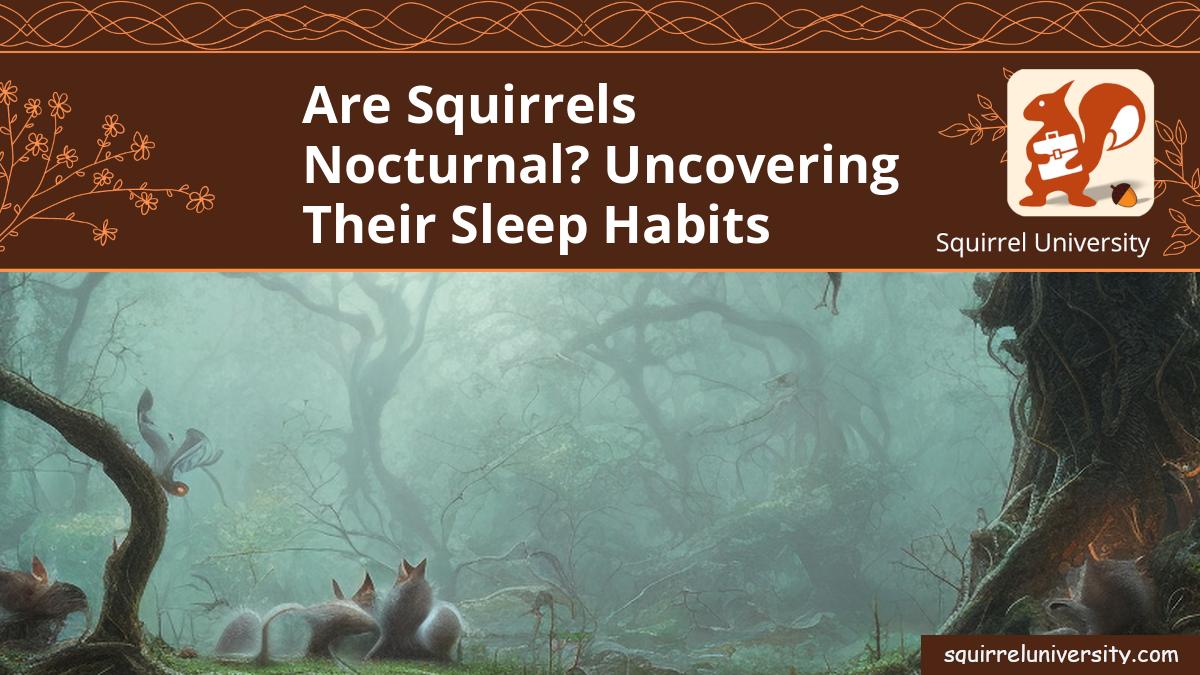As a passionate nature lover with several years of experience in observing and interacting with squirrels, I’m here to uncover their sleep habits for you. Are Squirrels Nocturnal? This is a question often asked by people who love animals and want to know more about these fascinating creatures. Let’s explore the sleeping habits of squirrels, get to know why they are nocturnal or diurnal, and have fun discovering these amazing animals!
Most squirrels are diurnal animals, meaning they are active during the day and inactive at night. This includes most tree squirrel species, such as gray squirrels and red squirrels. Flying squirrels, however, are an exception to this rule; they are nocturnal creatures that remain active after dark.
Are Squirrels Nocturnal?
The natural behavior of squirrels has been studied for many years, and one interesting topic is their sleep patterns. People often wonder if squirrels are nocturnal or diurnal – meaning active during the day versus the night. The answer to that question is not clear-cut, as it depends on the species of squirrel.
Nocturnal vs. Diurnal: What’s The Difference?
Nocturnal creatures are primarily active at night and rest during the day, while diurnal animals carry out their daily activities in the daylight and sleep during the night. Some mammals, like humans and certain rodents, have adapted biphasic behaviors called “cathemeral”. This type of behavior consists of both diurnal and nocturnal activity patterns with periods of rest in between them.
Why Are Squirrels Diurnal?
Tree squirrels are usually most active during daylight hours, when the weather is warmer. By taking advantage of the day’s sunlight, they can forage for food without having to worry about nighttime predators such as owls. At night, they seek shelter to keep warm in colder temperatures since it’s not ideal for finding suitable meals.
Where Do Squirrels Go at Night?
At night, these diurnal critters retreat to their nests for warmth and protection from predation. There are several variations of this behavior depending on each species’ natural habitat and predator/prey relationships.
The Nocturnal Flying Squirrel
Flying squirrels (Glaucomys sabrinus) are an exception to most rule, spending their nights foraging and gliding from tree to tree in search of food. With their large eyes well-suited for nocturnal vision and a pale coat that helps them blend into nighttime surroundings, these creatures have adapted perfectly to the nocturnal lifestyle.
The Diurnal Red Squirrel
The familiar red squirrel (Tamiasciurus hudsonicus) can also be seen gathering food during the day but will retreat back to its nest at dusk until sunrise. However, studies have found that red squirrels may change their sleeping patterns due to human presence or adverse weather conditions.
The Crepuscular Gray Squirrel
At twilight, North America’s crepuscular gray squirrels (Sciurus carolinensis) come alive and take advantage of the low light levels to venture out in search of food. Even during the winter months when night truly sets in around 8 pm, these furry foragers can still be spotted scampering about for something to eat.
A Day in the Life of a Squirrel
A day in the life of a squirrel is full of activity. From morning till night, they can be found collecting food, mobilizing between tree branches, and keeping warm. Squirrels are active during daylight hours, with peaks of activity mostly occurring in the early mornings and evenings.
They typically hide or rest during the hottest parts of the day to conserve energy. In cold weather, they may also find shelter at night to stay warm. To keep predators at bay, ground squirrels often enter into a state of true hibernation by decreasing their body temperatures and metabolism.
Sleeping Behavior of Diurnal Squirrels
Sleeping behavior of diurnal squirrels varies depending on species and environmental factors. For instance, gray squirrels are crepuscular, meaning they spend their active hours around dawn and dusk, when it’s harder for predators to spot them. Meanwhile, ground squirrels hibernate during cold months to conserve energy. Flying squirrels are an exception, however; they tend to be nocturnal and glide from tree to tree at night to find food.
Sleeping Behavior of Nocturnal Squirrels
Nocturnal squirrels have adapted to their environment, living a lifestyle that keeps them safe from predators. One such species is the Northern flying squirrel, which is active during night-time foraging and gliding between trees. Studies of the Northern flying squirrel and its Japanese counterpart suggest strong nocturnal behavior, though in cold winter weather they tend to stay inside their warm nests.
It’s important to note that flying squirrels are the exception rather than the rule; most tree squirrels are diurnal animals who prefer sleeping at night.
Sleeping Behavior of Crepuscular Squirrels
Gray squirrels have evolved eyesight that allows them to stay safe during daylight hours and be most active when light is dim. As a result, they often fit into the category of crepuscular animals due to their pattern of sleeping and waking up around dawn and dusk. In other words, gray squirrels display cathemeral behavior – though times vary, overall they experience cycles of activity in both day and night.
- Cathemeral: Activity periods occur sporadically throughout the day and night.
- Crepuscular: Sleep mostly during daylight hours with activity mainly around dawn and Dusk.
- Diurnal: Most active during daylight hours with some rest afterwards.
Squirrel Eyes and Vision
The size of a squirrel’s eyes plays a role in its sleeping pattern—diurnal squirrels have smaller eyes which help them absorb more light so they can see clearly during the day. The opposite is true for crepuscular gray squirrels who have larger eyes that allow them to see in low-light conditions as well as bright-light ones.
Likewise, each type of rodent has unique visual adaptations that make it easier for them to navigate their respective environments.
Where Do Squirrels Sleep?
Ground squirrels spend their nights in underground burrows—complex tunnel systems often housing multiple families. On the contrary, tree-dwelling squirrels spend their nights curled up snugly in leafy nests or holes in trees if available.
In colder months, all types of squirrel will slow down their activity levels considerably and remain relatively dormant for extended periods, occasionally waking up for brief spells before dozing off again.
Hibernation in Ground Squirrels
One particular species that utilizes hibernation is the ground squirrel (Spermophilus lateralis). This mammal lowers its body temperature significantly during winter months, along with its heart rate into a deep sleep state known as torpor where most energy is conserved until spring arrives.
Hibernation in Most Squirrels
Other types of rodents do not hibernate like ground squirrels, instead they stock their nests with food while it is still summer and spent much more time in their nests during the colder months. Their metabolism and body temperature slow down slightly during this period, and only return to normal when warmer weather returns.
Factors that Affect the Sleep Habits of Squirrels
Squirrels are most active during the day, but their sleep habits vary depending on several factors. Seasonal changes, dietary needs, and predator avoidance all play a role in when they rest. In winter months, they create shelter to stay warm while they hibernate; in warmer weather they look for food more often and switch to a crepuscular sleep pattern that provides protection against predators.
FAQ
Is it usual to observe a squirrel in the dark of night?
It is not unusual to see a squirrel during the night, but it is far less common than seeing them during the day. Squirrels have a circadian rhythm, making them naturally inclined towards diurnal behavior. Therefore, they are more active during daylight hours rather than at night.
At what point do squirrels stop being active?
Squirrels usually become less active as the day goes on. Generally, they become quiet around dusk and throughout the night; typically starting again in the early morning. As such, squirrels are typically most active during the middle of the day and begin to slow down in the late afternoon.
At what hour do squirrels usually show the most activity?
Squirrels are predominantly diurnal animals, meaning they are most active during the daylight hours. Generally speaking, they are most lively and active in the mornings and afternoons, with their activity tailing off in the late evenings as they prepare to rest for the night.
Where do squirrels take refuge when it is raining?
When it is raining, squirrels usually shelter themselves in their nests or dens. They often abandon old bird nests they find in trees and create a new nest with twigs and leaves as insulation from the cold and wet weather. In other instances, when squirrels cannot find suitable sheltering in tree nests, they scurry into burrows in the ground or brush piles for refuge.
Conclusion
In conclusion, while most species of squirrel are diurnal, flying squirrels are nocturnal creatures, meaning they are active during the night. This means that the answer to the question “Are Squirrels Nocturnal?” is yes–but only for certain types of squirrels. During the day, you will see diurnal tree squirrels scurrying about or sunning themselves on branches, but at night, you may catch a glimpse of a flying squirrel as it glides away with its big, fluffy tail.
No matter what type of squirrel you encounter, it’s fascinating to witness these small and bushy-tailed animals in their natural habitat. From gray to red to flying squirrels, all have something special to bring to the table—and that’s why the answer to “Are Squirrels Nocturnal?” is so interesting and unique!
You may also be interested in reading:

